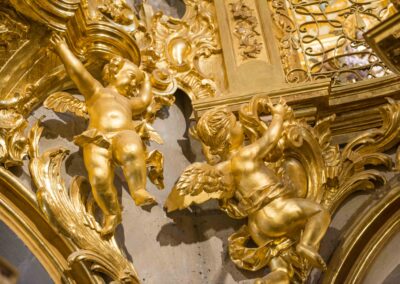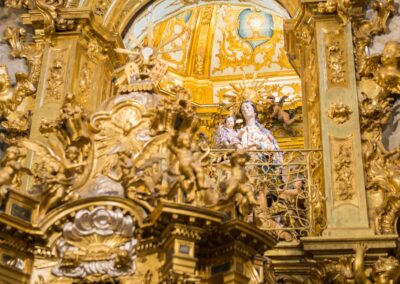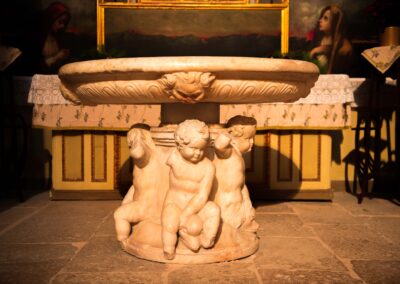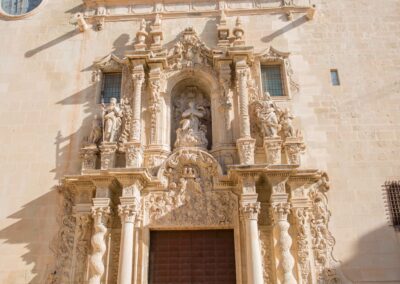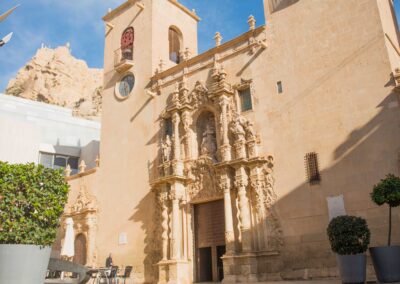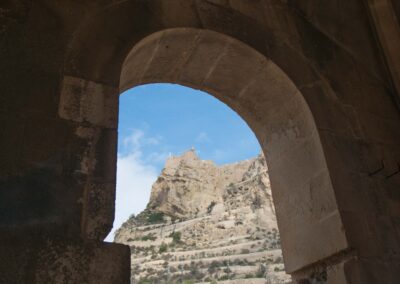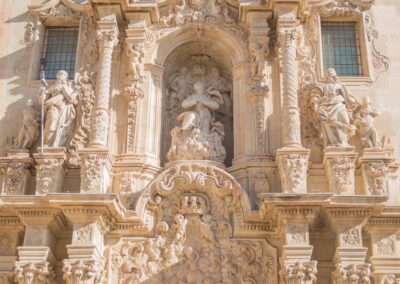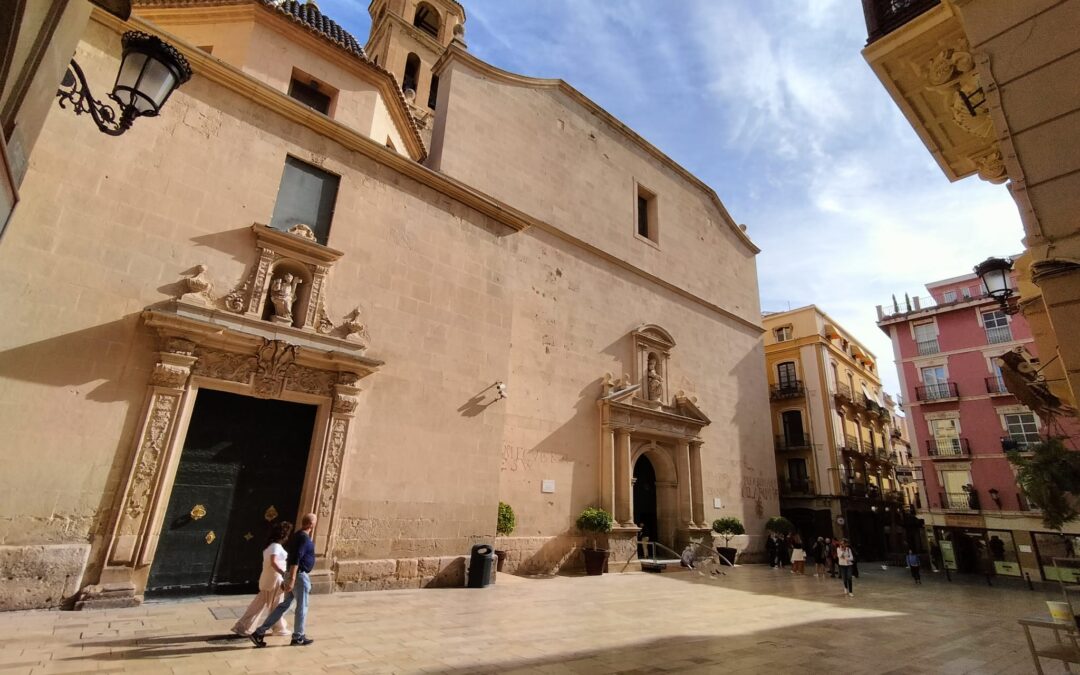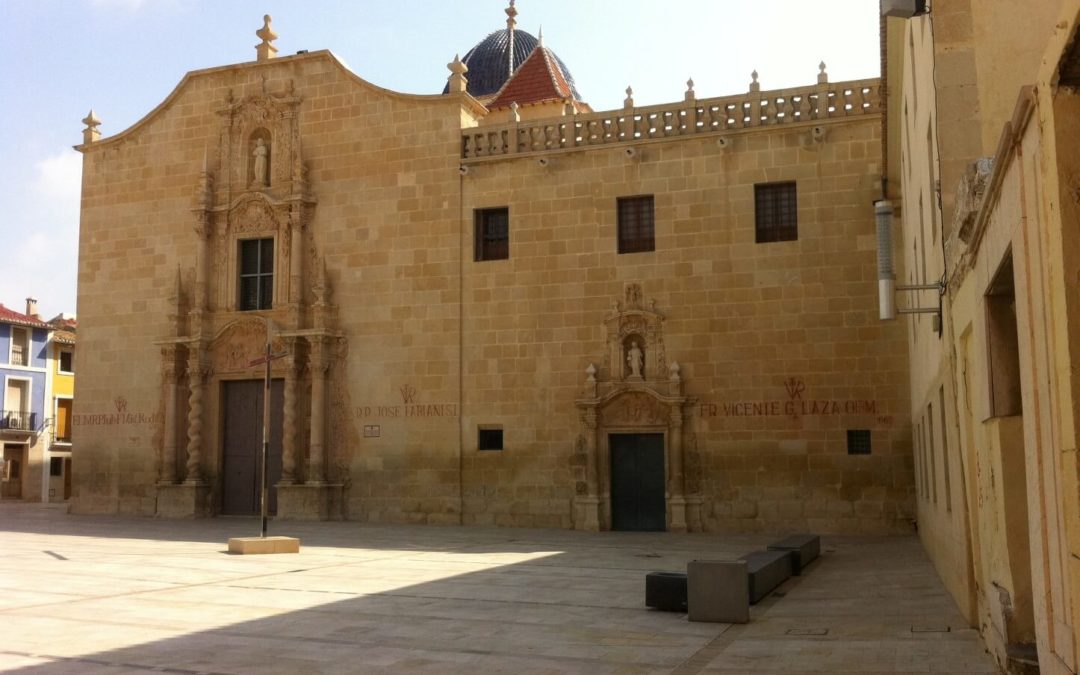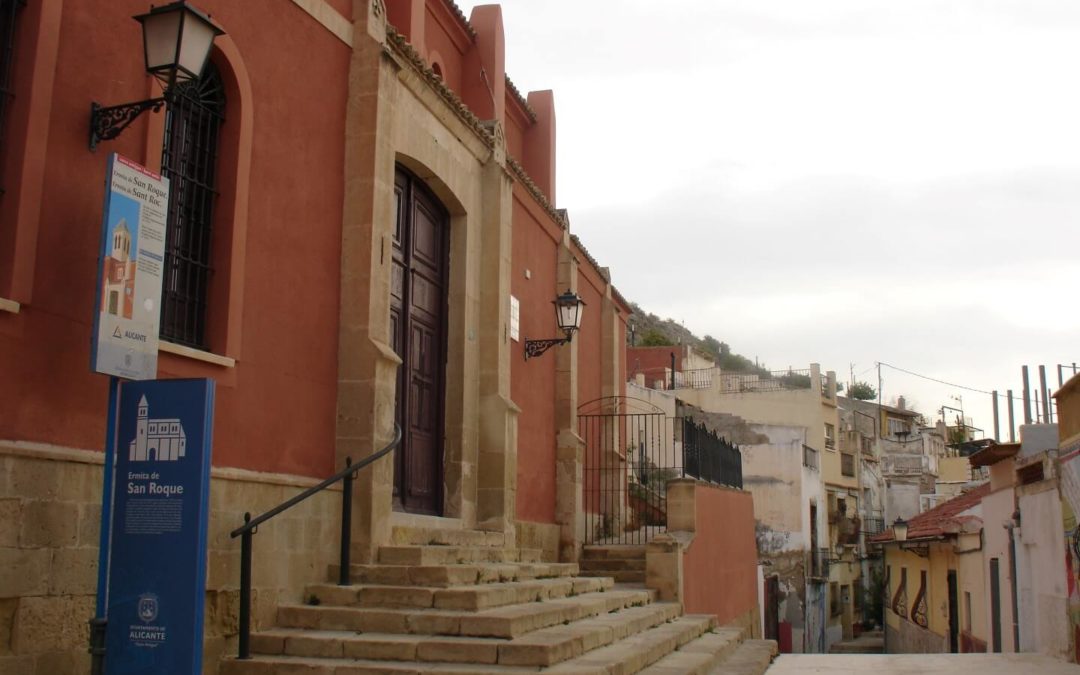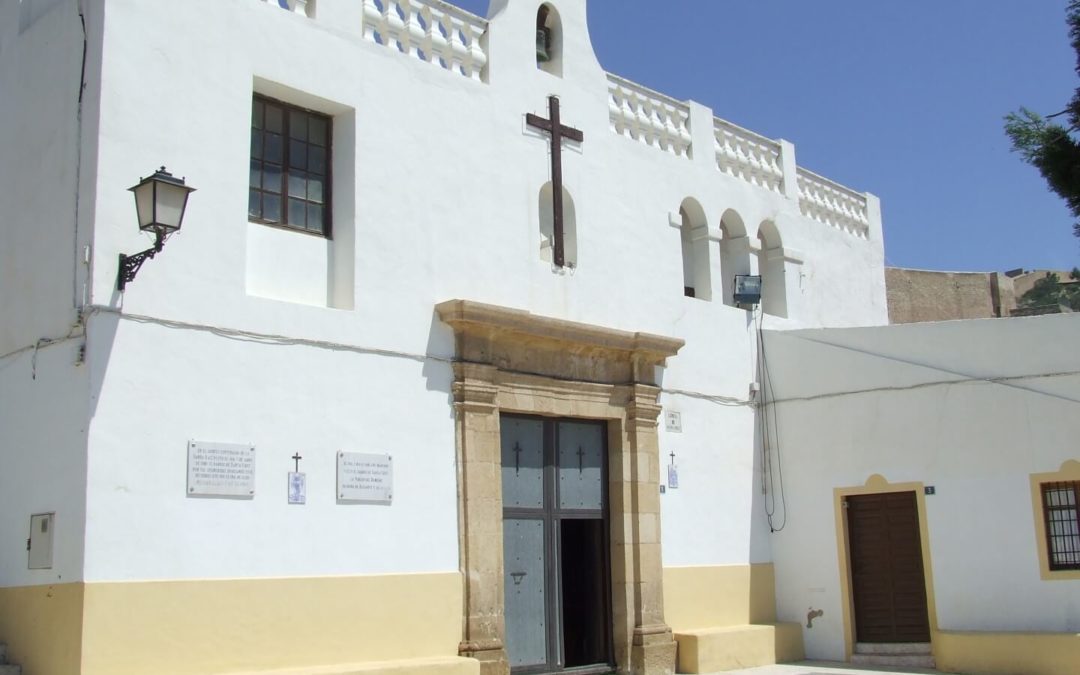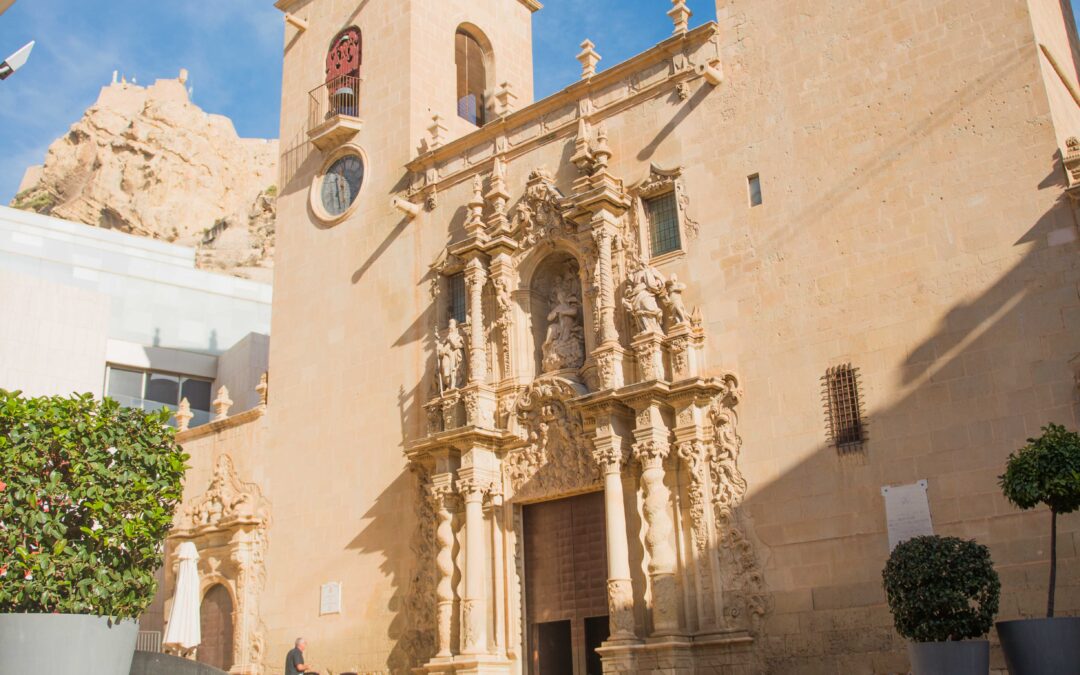
Santa María Basilica
History and Architecture
The Basilica of Santa Maria is the oldest religious building in Alicante, with its original construction dating back to the 14th century. This imposing Gothic temple, renovated in the 15th century after a fire, features a Baroque façade that reflects the contrast between its rich history and its architectural evolution over the centuries. Its asymmetrical towers, built between the 14th and 18th centuries, add a unique visual appeal, making it an ideal setting for any film production seeking a historical or dramatic atmosphere.
Inside, the basilica boasts a splendid Rococo high altar from the 18th century and richly ornamented chapels, such as those dedicated to the Immaculate Conception, Baptism, and Communion, creating perfect spaces for filming scenes requiring a solemn or highly aesthetic setting. The 1653 Valencian Baroque organ and the 16th-century baptismal font are additional visual elements that lend authenticity to any production aiming to capture the splendor of past eras.
A Cinematic Setting
The Basilica of Santa Maria is an ideal location for audiovisual productions of historical, dramatic, or period genres. Its Baroque façade, featuring the Virgin Mary sculpture by Juan Bautista Borja, combined with its intricately decorated interior, provides a majestic backdrop suitable for a wide range of genres, from religious films to historical dramas and thrillers.
Its main nave, without a transept, and the chapels nestled between the buttresses offer flexibility for diverse shot compositions and scenes. Meanwhile, the light streaming through its large Gothic windows adds a natural dramatic effect that enhances key elements of the visual narrative.
Adjacent Spaces
Beyond being an architectural gem, the basilica is strategically located near other cinematographically valuable sites, such as the Museum of Contemporary Art (MACA), the Plaza de la Santísima Faz, and Alicante’s City Hall. This allows for a fluid and versatile visual narrative that can seamlessly integrate both historical and modern exterior settings.
Technical Specifications for Filming Interior:
-
Main nave and chapels: Spacious interiors, perfect for long shots or choreographed action sequences. Controlled lighting is recommended to preserve historical elements.
-
Natural lighting: The interior benefits from natural light filtering through its Gothic windows, though artificial lighting may be necessary. Care should be taken not to alter the historic ambiance or damage surfaces.
-
Sound: The acoustics are exceptional due to the high vaults, making it an ideal location for capturing dialogues or musical scenes. However, preliminary sound tests are advised due to potential reverberations typical of such spaces.
Exterior:
-
Baroque façade: Ideal for wide shots or establishing shots that highlight its symmetry, punctuated by the two asymmetrical towers. Perfect for setting the historical context of a scene.
-
Plaza de Santa Maria: The exterior space in front of the basilica allows for the deployment of technical equipment, including cranes and cameras for panoramic or aerial shots.
Public Space Use and Safety Located in Alicante’s historic heart, any filming at the Basilica of Santa Maria must be carefully coordinated to minimize disruption to local traffic. Key planning aspects include:
-
Permits and authorizations: Managed through Alicante Film Office, authorization is required for public space occupancy, both in the plaza in front of the basilica and surrounding streets.
-
Set installations: Temporary sets may be installed around the plaza, provided they do not obstruct main entrances and that pavement and architectural surroundings are protected.
-
Public safety: If the plaza or parts of it are closed off, safety barriers and proper signage must be implemented to redirect pedestrians and ensure the safety of both the crew and the public.
-
Loading and unloading: The proximity to City Hall and other historic plazas offers nearby points for equipment loading and unloading. Coordination with local authorities is recommended to secure temporary vehicle access to restricted areas.
Facilities and Amenities
-
Loading and unloading zones: Nearby areas can be designated to facilitate equipment transport.
-
Electrical access: Portable generators may be necessary, subject to prior approval.
Parking Production trucks and support vehicles can arrange parking through Alicante Film Office. Given the limited access to the historic district, checking parking conditions in advance is advised.
Filming Availability
-
Hours: The basilica maintains regular worship and tourist visit schedules, so filming may need to take place outside these hours or on special days.
-
Best days for filming: Coordination with Alicante Film Office is recommended, as tourist traffic around the basilica may vary.
Application for a filming permit
Filming permits must be applied for through the appropriate institution. If you have any questions, you can contact the Alicante Film Office:
E-mail: info@alicantefilmoffice.com
Phone: (+34) 965 148 113 / (+34) 965 177 052
Important information:
For road closures or to reserve a space for parking production vehicles it is mandatory to obtain a permit which requires the approval of the Department of Safety and Traffic of the City of Alicante. For more details, see the filming permit application form.
At least 30 days are required for processing the necessary permits.

In accordance with Data Protection Legislation, Regulation (EU) 20161679 of 27 April 2016, we inform you that your personal data will be processed, under the responsibility of the Municipal Tourist Board, in order to implement or answer your request appropriately.
• The data will be processed exercising the powers attributed to the Municipal Tourist Board by Law 7/1985 of 2 April, Regulator of the Basis of the Local Regime, and by Law 39/2015 of 1 October, Common Administrative Procedure of Public Administrations, and will not be ceded to third parties, except in the case of legal obligation of assignment to other organisms.
• By means of a request addressed to the Municipal Tourist Board, you may exercise your rights of data access, rectification, deletion and portability as well as limitation or opposition to its processing.
• Additional information: You can consult additional and detailed information on Data Protection on our website:
https://www.alicantefilmoffice.com/en/privacy-policy/
Fees
Municipal fees for the use of public spaces for filming must be paid to the Alicante City Council through the Public Space Occupation Department. Regulations and rates vary depending on the type of production, filming locations, and duration at each site.
If you have any questions, feel free to contact us: info@alicantefilmoffice.com, Tel: (+34) 965 148 113.
View Public Space Occupation Fees
Address
Basílica de Santa María
Plaça. Santa María, 1, 03001 Alacant
Tel:(+34) 681 140 483
basilicaalicante@procuratiocultural.com
https://www.basilicaalicante.com/

